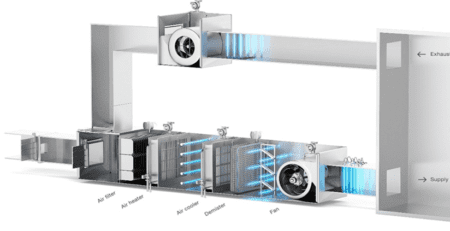By Dr Rhys Thomas, PP-L Chief Medical & Scientific Officer
& Paul Waldeck, PP-L Chief Technical Officer
We are now at one of the most challenging and critical stages in our fight against a virus which has already been linked to the deaths of more than 84,000 people in the UK.
While more than half a million people have now had their first dose of a vaccine, cases are rising rapidly with a new, more infectious variant of the virus spreading across large parts of the country.
Over many months, PP-L Health technology Solutions has been calling for the government to take the necessary steps to prevent airborne transmission: We have written to all Members of Parliament, we have written to organisations including SAGE, HSE, FSA and the All Party Parliamentary Group on Air Pollution to raise awareness of the simple steps which could and should be taken.
Here, we hope to set out, in simple terms, how and why we must address the airborne transmission of the virus immediately if we’re to avoid another year of lockdowns, economic damage and tens of thousands of deaths.
The airborne transmission of COVID-19
COVID-19 is primarily spread through airborne transmission. Since the start of the pandemic, a wide range of scientific studies have demonstrated that people who are infected with the virus often produce microscopic droplets in their breath – also referred to as microdroplets or aerosols – which can infect others. (All sources are listed at the end of this article).
A recent study into the virus showed that 57% of people are infected via inhalation, compared to 35% infected by droplet transmission and 8% through physical contact with infected surfaces.
These microdroplets, which measure less than 5 micrometres, can remain airborne for up to 16 hours and travel tens of metres through an indoor environment. Airborne microdroplets can even linger in the air outside, particularly when the weather is cold and damp and the air is relatively still. Studies have also shown that they can bond with airborne pollutants, helping them to remain viable for longer, remain closer to ground level and travel further distances.
When airborne, these microdroplets, which behave in a similar way to smoke or steam, can easily be inhaled by other people, delivering the pathogen directly to the throat and lungs where it can thrive.
The best ways to prevent these microdroplets from being transmitted is for all people to wear appropriate face masks (face shields alone are not enough), including in busy outside or urban areas, and for all occupied indoor environments to either ensure constant and regular air changes through ventilation to an outside source o clean, fresh air and/or to use safely engineered germicidal ultraviolet air disinfection systems (UVGI also known as UV-C).
These steps may seem severe to some, but studies have shown that each of these are effective in preventing the transmission of airborne pathogens.
A dangerous situation
These interventions are now more important than ever before: The New and Emerging Respiratory Virus Threats Advisory Group (NERVTAG), which advises the government on the threat posed by new and emerging respiratory viruses has said that the new strain of COVID-19 has a growth rate 71% faster than other variants and it is capable of increasing the R-value by 0.39 to 0.93.
As Independent SAGE has explained, the lowest the R rate has been under the tiered system of restrictions in the UK was 0.8. From this, we can surmise that with the new strain, we cannot expect R to remain below 1.19 without Tier 4 restrictions being in place for large areas for the country for many months.
Already, the new strain is causing major disruption and damage to the UK’s economy with shops and businesses closed, many having to spend Christmas alone and with other countries having stopped people and freight from the UK crossing their borders.
There is also the risk that, with the increased transmission of the virus, the chances of further mutations to occur, leading to more strains which could be more contagious or more harmful than the variants which are already in circulation.
With this rapidly changing situation, we desperately calling for the increased usage of a range of measures which are proven to prevent the airborne transmission of COVID-19 and all other known airborne pathogens: Primarily, the increased use and strengthened guidance on the use of face masks and mandatory measures to destroy or extract airborne viral particles through improved ventilation and air disinfections systems which use germicidal ultraviolet light (UV-C).
Whether or not the government takes these steps, or heeds the advice of growing numbers of scientists who are recommending the use of UV-C, we urge members of the public, business leaders, property owners, and everyone with responsibility for areas where people must gather, to do what they can to go above and beyond the government guidance in this way, if they wish to be more COVID-secure.
How to reduce airborne transmission
There is a wealth of evidence on the effectiveness of face masks in reducing the transmission of airborne viruses.
Studies have shown that N95 masks can filter 95% of aerosols while surgical masks can filter 89.5%. Even masks made of two-layers of cotton can filter 82% of aerosols while a single layer of cotton can filter 51%. Even when outdoors, people should wear face masks, particularly in busy, densely populated or polluted areas.
Meanwhile, UV-C has been used for 120 years as a means of disinfecting pathogens, with more than 5,000 studies showing its efficacy against all known viruses. Recent studies have shown that exposure to UV-C can destroy COVID-19 in milliseconds.
When appropriate UV-C lighting is either retrofitted within an existing heating, ventilation or air conditioning system (HVAC) or installed as a self-contained air circulation and disinfection system, the technology can quickly disinfect a whole room full of air in minutes on a continuous basis, even when it is occupied.
This can rapidly reduce the airborne viral load in an environment and prevent it from increasing infectivity, with systems capable of disinfecting all of the air in minutes.
The vaccines being given to people across the UK will be of great help, but, as the World Health organisation has warned, they cannot contain the virus alone and we have to find other tools alongside medicines to live with this viral threat.
If we want schools to remain open without transmitting the virus to staff and pupils, if we want hospitals to treat patients safely, if we want people to return to work and regain their freedoms, we must quickly improve our efforts to prevent the spread of the virus, not just to contain it.
If you would like any additional information about UV-C air disinfection technology or to speak to a member of our team, please contact us.
Dr Rhys Thomas MM’BBs MD FRCA Dip IMC RC’Ed
Chief Medical & Scientific Officer
PP-L Health Technology Solutions
Paul Waldeck B.Eng.(Hons.) ,C.Eng,. MI.C.E., M.I.Struct.E..
Chief Technical Officer
PP-L Health Technology Solutions
Sources:
http://www.ncbi.nlm.nih.gov/pmc/articles/PMC7151430/
http://www.tandfonline.com/doi/full/10.1080/15459624.2020.1784427
http://www.hindawi.com/journals/apm/2011/124064/
http://www.ncbi.nlm.nih.gov/books/NBK531468/
http://advances.sciencemag.org/content/6/36/eabd3083
http://pubmed.ncbi.nlm.nih.gov/24229526/
http://www.sciencedirect.com/science/article/pii/S2352431620301802?via%3Dihub
http://pubs.acs.org/doi/10.1021/acsnano.0c03252
http://www.businessinsider.com/best-masks-for-coronavirus-chart-2020-9?r=US&IR=T
http://science.sciencemag.org/content/370/6514/303.2
http://wwwnc.cdc.gov/eid/article/26/9/20-1806_article
http://www.nejm.org/doi/full/10.1056/NEJMc2004973
http://wellcomeopenresearch.org/articles/5-83
http://www.ncbi.nlm.nih.gov/pmc/articles/PMC7156797/
http://www.ncbi.nlm.nih.gov/pmc/articles/PMC7435279/
http://www.thelancet.com/journals/lancet/article/PIIS0140-6736(19)31889-6/fulltext
http://journals.plos.org/plosmedicine/article?id=10.1371/journal.pmed.1000043#authcontrib






Leave a Reply